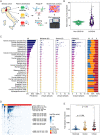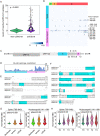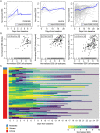This is a preprint.
Serological Responses to Human Virome Define Clinical Outcomes of Italian Patients Infected with SARS-CoV-2
- PMID: 32908997
- PMCID: PMC7480049
- DOI: 10.1101/2020.09.04.20187088
Serological Responses to Human Virome Define Clinical Outcomes of Italian Patients Infected with SARS-CoV-2
Update in
-
Serological responses to human virome define clinical outcomes of Italian patients infected with SARS-CoV-2.Int J Biol Sci. 2022 Sep 1;18(15):5591-5606. doi: 10.7150/ijbs.78002. eCollection 2022. Int J Biol Sci. 2022. PMID: 36263161 Free PMC article.
Abstract
Severe acute respiratory syndrome coronavirus 2 (SARS-CoV-2) is responsible for the pandemic respiratory infectious disease COVID-19. However, clinical manifestations and outcomes differ significantly among COVID-19 patients, ranging from asymptomatic to extremely severe, and it remains unclear what drives these disparities. Here, we studied 159 hospitalized Italian patients with pneumonia from the NIAID-NCI COVID-19 Consortium using a phage-display method to characterize circulating antibodies binding to 93,904 viral peptides encoded by 1,276 strains of human viruses. SARS-CoV-2 infection was associated with a marked increase in individual's immune memory antibody repertoires linked to trajectories of disease severity from the longitudinal analysis also including anti-spike protein antibodies. By applying a machine-learning-based strategy, we developed a viral exposure signature predictive of COVID-19-related disease severity linked to patient survival. These results provide a basis for understanding the roles of memory B-cell repertoires in COVID-19-related symptoms as well as a predictive tool for monitoring its clinical severity.
Conflict of interest statement
Declaration of Interests:
All authors declare no conflicts of interest.
Figures




References
-
- Amanna I.J., Carlson N.E., and Slifka M.K. (2007). Duration of humoral immunity to common viral and vaccine antigens. N Engl J Med 357, 1903–1915. - PubMed
-
- Braun J., Loyal L., Frentsch M., Wendisch D., Georg P., Kurth F., Hippenstiel S., Dingeldey M., Kruse B., Fauchere F., et al. (2020). SARS-CoV-2-reactive T cells in healthy donors and patients with COVID-19. Nature. - PubMed
Publication types
LinkOut - more resources
Full Text Sources
Miscellaneous
